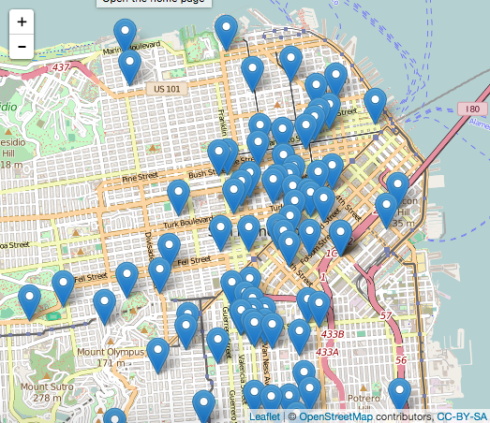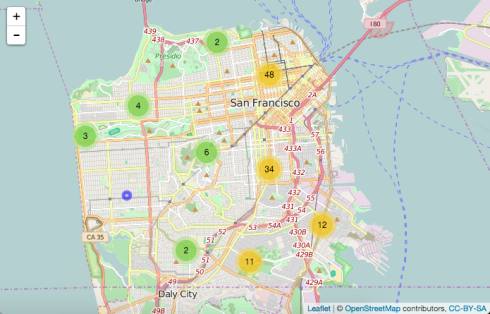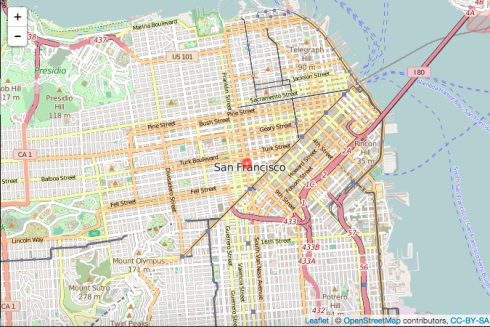Leaflet is an JavaScript library for building interactive maps. RStudio released a package that allows us to build these maps in R! You can do some really cool things in Leaflet, and I will demonstrate a few of those below. Leaflet is compatible with Shiny apps and R Markdown documents.
As mentioned on the RStudio page, the basic steps to create a Leaflet map are:
1. Create a map widget using
leaflet()
2. Add layers to the map usingaddTiles(),addMarkers(), etc.
3. Print the map.
Okay, let’s get started. We will need the leaflet and magrittr packages for this.
Let’s create a basic map centered at San Francisco. First, we create a widget by calling leaflet(). Then, we add tiles to the map using addTiles(). By default, it uses Open Street Map tiles. If you would like to use other tiles, please refer here. We can set the desired longitude and latitude that we want the map to be centered at, and also set the zoom level using the setView() function. The addMarker() function allows us to add a marker at our desired location, with it’s own popup message!
library(leaflet) library(magrittr) SFmap <- leaflet() %>% addTiles() %>% setView(-122.42, 37.78, zoom = 13) %>% addMarkers(-122.42, 37.78, popup = 'Bay Area') SFmap
This gives the following map:

If you click the blue marker, you will see a small popup with the text ‘Bay Area’. There are a variety of options to customize the marker. For example, addCircleMarkers() lets you use circle shaped markers instead of the default ones. You can even add your own icons to use as markers (more info here and here)!
The above map with a circle marker can be built as follows:
SFmap <- leaflet() %>% addTiles() %>% setView(-122.42, 37.78, zoom = 13) %>% addCircleMarkers(-122.42, 37.78, popup = 'Bay Area', radius = 5, color = 'red')
Let’s plot an interactive map showing the location of incidents reported to the San Francisco Police Department. The data is available here. Let’s read in the data and see what it looks like.
SFdata <- read.csv('SFPD_Incidents_-_Current_Year__2015_.csv')
head(SFdata)
IncidntNum Category Descript DayOfWeek Date Time PdDistrict Resolution Address X Y
1 150927700 BURGLARY BURGLARY OF APARTMENT HOUSE, UNLAWFUL ENTRY Thursday 10/22/2015 23:59 CENTRAL NONE 900 Block of SUTTER ST -122.4160 37.78823
2 150927700 SEX OFFENSES, FORCIBLE SEXUAL BATTERY Thursday 10/22/2015 23:59 CENTRAL NONE 900 Block of SUTTER ST -122.4160 37.78823
3 150926570 ASSAULT BATTERY Thursday 10/22/2015 23:45 RICHMOND NONE 100 Block of 19TH AV -122.4787 37.78508
4 150925312 STOLEN PROPERTY STOLEN PROPERTY, POSSESSION WITH KNOWLEDGE, RECEIVING Thursday 10/22/2015 23:40 SOUTHERN JUVENILE BOOKED 0 Block of SPEAR ST -122.3949 37.79311
5 156262768 LARCENY/THEFT PETTY THEFT OF PROPERTY Thursday 10/22/2015 23:40 SOUTHERN NONE MARKET ST / 6TH ST -122.4103 37.78223
6 150925312 ROBBERY ROBBERY, ARMED WITH A DANGEROUS WEAPON Thursday 10/22/2015 23:40 SOUTHERN JUVENILE BOOKED 0 Block of SPEAR ST -122.3949 37.79311
(There is another location column at the end which I omitted here as it is just a concatenation of the X and Y columns.)
Now let us look at how many incidents of each category were reported.
table(SFdata$Category)
ARSON ASSAULT BAD CHECKS BRIBERY BURGLARY DISORDERLY CONDUCT DRIVING UNDER THE INFLUENCE
255 10711 26 59 4749 396 360
DRUG/NARCOTIC DRUNKENNESS EMBEZZLEMENT EXTORTION FAMILY OFFENSES FORGERY/COUNTERFEITING FRAUD
3315 473 115 25 54 561 2523
GAMBLING KIDNAPPING LARCENY/THEFT LIQUOR LAWS LOITERING MISSING PERSON NON-CRIMINAL
22 286 34683 133 24 3755 15360
OTHER OFFENSES PORNOGRAPHY/OBSCENE MAT PROSTITUTION ROBBERY RUNAWAY SECONDARY CODES SEX OFFENSES, FORCIBLE
16143 4 261 3054 124 1676 687
SEX OFFENSES, NON FORCIBLE STOLEN PROPERTY SUICIDE SUSPICIOUS OCC TREA TRESPASS VANDALISM
15 777 64 4367 1 1093 6309
VEHICLE THEFT WARRANTS WEAPON LAWS
6361 5378 1346
To ensure that the map is plotted quickly, I am going to subset the data to only include observations pertaining to bribery or suicide.
data <- subset(SFPDdata, Category == 'BRIBERY' | Category == 'SUICIDE')
Now, let us plot all these incidents on the map!
SFMap %>% addTiles() %>% setView(-122.42, 37.78, zoom = 13) %>% addMarkers(data = data, lng = ~ X, lat = ~ Y, popup = data$Category) SFMap
The map looks like this:

Here, clicking on each marker will give a popup showing whether the incident which occurred at that particular location was bribery or suicide.
A lot of the markers are clumped together rather closely. We can cluster them together by specifying clusterOptions as follows:
SFMap %>%
addTiles() %>%
setView(-122.42, 37.78, zoom = 13) %>%
addCircleMarkers(data = data, lng = ~ X, lat = ~ Y, radius = 5,
color = ~ ifelse(Category == 'BRIBERY', 'red', 'blue'),
clusterOptions = markerClusterOptions())
which will give the following map:

The number inside each circle represents the total number of incidents in that area. Areas with higher incidents are marked by yellow circles and areas with lower incidents are marked by green circles. When you click on a cluster, the map will automatically zoom into that area and split into smaller clusters or show the individual incidents depending on how zoomed in you are. The circle markers are colored red for incidents corresponding to bribery, and blue for incidents corresponding to suicide.
That brings us to the end of the article. I hope you enjoyed it. If you have any questions/feedback, please feel free to leave a comment or reach out to me on Twitter.
